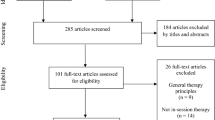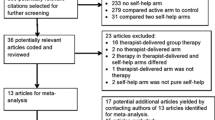Abstract
One hundred and seventy-three psychotherapists from 43 Midwestern mental health clinics responded to a survey which addressed therapists' attitudes and beliefs on service delivery topics relevant to client premature therapy termination. Therapists' responses were contrasted with known client and service delivery data. Therapists preferred a treatment duration longer than that expected by clients, overestimated actual treatment length, underestimated actual dropout rates and cited dislike of therapy or the therapist less often than clients did as reasons for premature termination. Causes of therapists' overestimates of treatment length and continuance, and their relevance to the dropout problem, were discussed.
Similar content being viewed by others
References
Acosta, F.X. (1980). Self-described reasons for premature termination of psychotherapy by Mexican American, Black American, and Anglo-American patients.Psychological Reports, 47, 435–443.
Baekeland, F., & Lundwall, L (1975). Dropping out of treatment: A critical review.Psychological Bulletin, 82, 738–783.
Detlefsen, E.G., & Pedolsky, A. (Eds.). (1980).National Directory of Mental Health: A Guide to Adult Outpatient Mental Health Facilities and Services Throughout the United States. New York: Neal-Schumann Publishers.
Farley, W.O., Peterson, K.D., Spanos, G. (1975). Self-termination from a child guidance center.Community Mental Health Journal, 11, 325–334.
Fiester, A.R., Mahrer, A.R., Giambra, L.J., & Ormiston, D.W. (1974) Shaping a clinic population: The dropout problem reconsidered.Community Mental Health Journal, 10, 173–179.
Garfield, S.L. (1963) a note on patients' reasons for terminating therapy.Psychological Reports, 13, 38.
Garfield, S.L. (1978) Research on client variables in psychotherapy and behavior change, (2nd Ed.) New York: John Wiley.
Garfield, S.L. (1980)Psychotherapy: An eclectic approach. New York: Wiley & Sons.
Garfield, S.L., & Wolpin, M. (1963) Expectations regarding psychotherapy.Journal of Nervous and Mental Disease, 137, 353–362.
Koss, M.P. (1979). Length of psychotherapy for clients seen in private practice.Journal of Consulting and Clinical Psychology, 47, 210–212.
National Institute of Mental Health (1979) Report of the work group on health insurance, November 1974. Cited in Ciarlo, J.A., Annual evaluation report for 1975 of the Northwest Denver Mental Health Center. In C. Windle (Ed.),Reporting Program Evaluations: Two Sample Community Mental Health Center Annual Reports. Rockville, Md.: Department of Health, Education and Welfare.
National Institute of Mental Health (1981)Provisonal data on federally funded community mental health centers, 1978–1979. Report prepared by the Survey and Reports Branch, Division of Biometry and Epidemiology. Washington, D.C.: U.S. Government Printing Office.
Norcross, J.C., & Wogan, M. (1983). American psychotherapists of diverse persuasions: Characteristics, theories, practices, and clients.Professional Psychology: Research and Practice, 14, 529–539.
Overall, B., & Aronson, H. (1962). Expectations of psychotherapy in lower socioeconomic class patients.American Journal of Orthopsychiatry, 32, 271–272.
Pekarik, G. (1983a) Follow-up adjustment of outpatient dropouts.American Journal of Orthopsychiatry, 53, 501–511.
Pekarik, G. (1983b) Improvement in clients who have given different reasons for dropping out of treatment.Journal of Clinical Psychology, 39, 909–913.
Pekarik, G. (1985). Coping with dropouts.Professional Psychology: Research and Practice, 16, 114–123.
Pekarik, G., & Wierzbicki, M. (in press). The relationship between clients' expected and actual treatment duration.Psychotherapy.
Prochaska, J.O. & Norcross, J.C. (1983). Contemporary psychotherapists: A national survey of characteristics, practices, orientations and attitudes.Psychotherapy: Theory, Research & Practice, 20, 161–173.
Report of the task panel on community mental health centers assessment. (1978). InTask Reports Submitted to the President's Commission on Mental Health. (Stock No. 040-000-00391-6). Washington, D.C.: U.S. Government Printing Office.
Strupp, H. (1978). Psychotherapy research and practice: An overview. In S.L. Garfield & A.E. Bergin (Eds.),Handbook of Psychotherapy and Behavior Change, (2nd Ed.) pp. 3–22, New York: Wiley.
Taube, C.A., & Barrett, S.A. (1985). Mental Health, United States 1985. (DHHS Publication No. (ADM) 85-1378). Washington D.C.: U.S. Government Printing Office.
Author information
Authors and Affiliations
Rights and permissions
About this article
Cite this article
Pekarik, G., Finney-Owen, K. Outpatient clinic therapist attitudes and beliefs relevant to client dropout. Community Ment Health J 23, 120–130 (1987). https://doi.org/10.1007/BF00757166
Issue Date:
DOI: https://doi.org/10.1007/BF00757166




